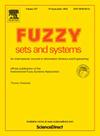Characterizations of fuzzy implications by the laws of contraposition
IF 3.2
1区 数学
Q2 COMPUTER SCIENCE, THEORY & METHODS
引用次数: 0
Abstract
The laws of contraposition, which are based on fuzzy implications and negations, play pivotal roles in fuzzy logic. This study introduces and exemplifies two novel types of fuzzy implications: -implications and -implications. These are derived from aggregation functions, disjunctors (conjunctors), and fuzzy negations. Prominent fuzzy implications like , , , , , and -implications can be subclassified under these newly introduced types. Then, we provide an axiomatic characterization of these two novel types of fuzzy implications based on the laws of contraposition. Furthermore, this research not only broadens our understanding of the axiomatic characterization of well-known fuzzy implications, such as -implications and -implications but also introduces a fresh perspective for interpreting relations between these implications.
求助全文
约1分钟内获得全文
求助全文
来源期刊

Fuzzy Sets and Systems
数学-计算机:理论方法
CiteScore
6.50
自引率
17.90%
发文量
321
审稿时长
6.1 months
期刊介绍:
Since its launching in 1978, the journal Fuzzy Sets and Systems has been devoted to the international advancement of the theory and application of fuzzy sets and systems. The theory of fuzzy sets now encompasses a well organized corpus of basic notions including (and not restricted to) aggregation operations, a generalized theory of relations, specific measures of information content, a calculus of fuzzy numbers. Fuzzy sets are also the cornerstone of a non-additive uncertainty theory, namely possibility theory, and of a versatile tool for both linguistic and numerical modeling: fuzzy rule-based systems. Numerous works now combine fuzzy concepts with other scientific disciplines as well as modern technologies.
In mathematics fuzzy sets have triggered new research topics in connection with category theory, topology, algebra, analysis. Fuzzy sets are also part of a recent trend in the study of generalized measures and integrals, and are combined with statistical methods. Furthermore, fuzzy sets have strong logical underpinnings in the tradition of many-valued logics.
 求助内容:
求助内容: 应助结果提醒方式:
应助结果提醒方式:


